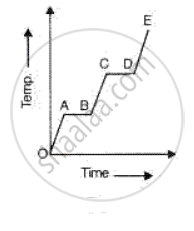Advertisements
Advertisements
प्रश्न
Study the following procedure and answer the questions below:
1. Take 3 spheres of iron, copper and lead of equal mass.
2. Put all the 3 spheres in boiling water in a beaker for some time.
3. Take 3 spheres out of the water. Put them immediately on a thick slab of wax.
4. Note, the depth that each sphere goes into the wax.
i) Which property of substance can be studied with this procedure?
ii) Describe that property in minimum words.
iii) Explain the rule of heat exchange with this property.
उत्तर
i. Specific heat
ii. Specific heat : The amount of heat energy required to raise the temperature of a unit mass of an object by 1oC .
iii. According to the principle of hear exchange :
Heat energy lost by the hot object = Heat energy gained by the cold
object
In this activity heat absorbed by iron sphere is transmitted more in the wax, hence sphere goes deepest in to wax, while lead sphere absorbs less heat, resulting in less transmission of heat in the wax hence sphere goes the least depth in the wax.
APPEARS IN
संबंधित प्रश्न
Give one example where high specific heat capacity of water is used as cooling purposes?
Describe a method to determine the specific heat capacity of a solid, like a piece of copper ?
State the impact of global warming on life on the earth.
What is carbon tax?
Who shall pay carbon tax ?
(i) State whether the specific heat capacity of a substance remains the same when its state changes from solid to liquid.
(ii) Give one example to support your answer.
A substance is heated at a constant rate from a low temperature to a high temperature. A graph of temperature against time is shown in the figure. Which part or parts of the graph correspond(s) to the substance existing in two states?

A solid of mass 80 g at 80°C is dropped in 400 g water at 10°C. If final temp. is 30°C, find the sp. heat cap. of the solid.
The farmers fill their fields with water in winter. Give reason.
Explain, why water is considered as best liquid for quenching thirst?
Discuss how high specific heat capacity of water helps in formation of land and sea breeze.
How much heat energy is necessary to raise the temperature of 5 kg of water from 20°C to 100°C?
Write the name.
The amount of heat absorbed at constant temperature by unit mass of a liquid to convert into gaseous phase.
Explain why the specific heat capacity at constant pressure is greater than the specific heat capacity at constant volume.
Derive Meyer’s relation for an ideal gas.
For a gas, `"R"/"C"_"v"=0.4`, where R Is universal gas constant and Cv is the molar specific heat at constant volume. The gas is made up of molecules, which are ______
A geyser heats water flowing at a rate of 2.0 kg per minute from 30°C to 70°C. If the geyser operates on a gas burner, the rate of combustion of fuel will be ______ g min-1.
[Heat of combustion = 8 × 103 Jg-1 Specific heat of water = 4.2 Jg-1°C-1]
